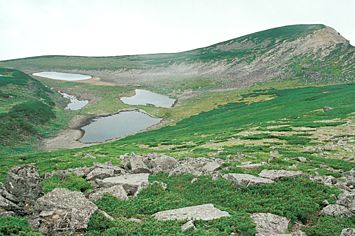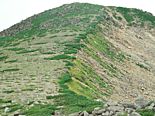Japan
Japan is very mountainous and two thirds of the land area are covered by forests. The climate
ranges from subtropical to cool temperate (N-Hokkaido). The examples presented here are from
the central, temperate part, namely from Mt. Fuji and Mt. Norikura near Matsumoto. The climate
is very maritime in these regions, with lots of snow in winter and mild, humid summers. Most
taxa belong to genera which are also dominant in the Alps and represent the holarctic flora.
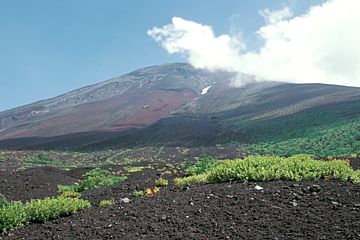
1 - The flanks of Mt. Fuji, here just above treeline at 2200 m.
1 - The flanks of Mt. Fuji, here just above treeline at 2200 m.

2 -
Polygonum cuspidatum
(Polygonaceae), the dominant shrub on the cinder slopes near treeline.
2 -
Polygonum cuspidatum
(Polygonaceae), the dominant shrub on the cinder slopes near treeline.

3 -
Carpets of lichens (
Cladina sp.
(Cladoniaceae)) and
Vaccinium vitis-idaea
(Ericaceae) near treeline.
3 -
Carpets of lichens (
Cladina sp.
(Cladoniaceae)) and
Vaccinium vitis-idaea
(Ericaceae) near treeline.

4 -
Vaccinium vitis-idaea
(Ericaceae) (Mt. Fuji)
4 -
Vaccinium vitis-idaea
(Ericaceae) (Mt. Fuji)
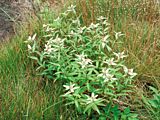
5 -
Mountain meadow at 2800 m with
Leontopodium japonicum
(Asteraceae).
5 -
Mountain meadow at 2800 m with
Leontopodium japonicum
(Asteraceae).

6 -
Campanula lasiocarpa
(Campanulaceae) (3000 m)
6 -
Campanula lasiocarpa
(Campanulaceae) (3000 m)
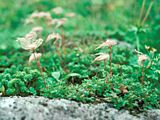
7 -
Geum pentapetula
(Rosaceae) (Mt. Norikura, 3000 m)
7 -
Geum pentapetula
(Rosaceae) (Mt. Norikura, 3000 m)
8 - The alpine landscape in the Mt. Norikura region.
10 -
Wind and topography control snow distribution and thus, vegetation patterns.

14 -
Gentiana algida
(Gentianaceae) (2850 m)
14 -
Gentiana algida
(Gentianaceae) (2850 m)
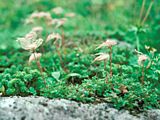
15 -
Geum pentapetula
(Rosaceae) (Mt. Norikura, 3000 m)
15 -
Geum pentapetula
(Rosaceae) (Mt. Norikura, 3000 m)








